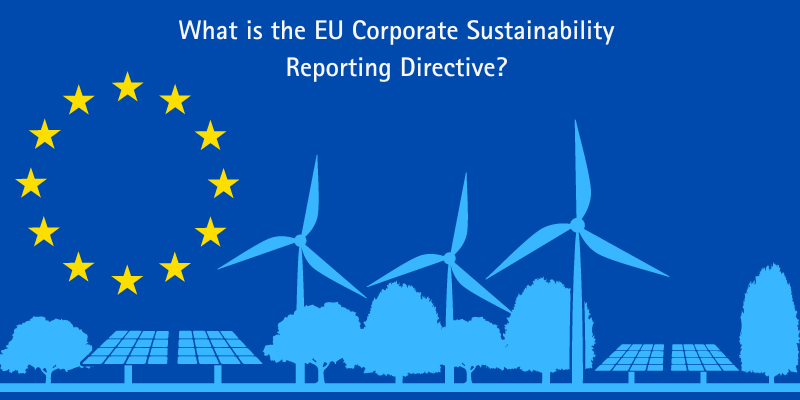What is the EU Corporate Sustainability Reporting Directive?
In an era where sustainability has transcended buzzword status to become a central tenet of corporate responsibility, the European Union has taken a significant step forward with the introduction of the Corporate Sustainability Reporting Directive (CSRD).
This landmark directive represents a pivotal evolution from its predecessor, the Non-Financial Reporting Directive (NFRD), aiming to enhance the transparency, consistency, and comparability of sustainability reporting across EU member states. As businesses worldwide grapple with the pressing need to align their operations with environmental, social, and governance (ESG) criteria, the CSRD emerges as a critical tool.
It not only broadens the scope of companies under its purview but also sets rigorous new standards for reporting, ensuring that sustainability is woven into the fabric of corporate governance and accountability across Europe.
What is the Corporate Sustainability Reporting Directive (CSRD)?

The Corporate Sustainability Reporting Directive is a significant piece of legislation passed by the European Union aimed at increasing transparency and requiring companies to disclose information on the way they operate and manage social and environmental challenges. This directive is an expansion and revision of the earlier Non-Financial Reporting Directive (NFRD), which was introduced to improve the reporting of non-financial information by certain large companies. Key aspects of the CSRD include:
Expanded Applicability
The CSRD extends the reporting requirements to all large companies and all companies listed on regulated markets (except micro-enterprises), significantly increasing the number of companies that need to disclose sustainability information compared to the NFRD.
Standardised Reporting
It introduces more detailed reporting requirements and mandates specific standards to ensure sustainability information's consistency, comparability, and relevance. This makes it easier for investors, consumers, and other stakeholders to understand and use the reported information.
Assurance Requirement
The directive requires that the reported sustainability information undergoes an assurance process to verify its accuracy, increasing the reliability of the data provided.
Double Materiality
Companies need to report not only on how sustainability issues affect their business (financial materiality) but also on the impact their activities have on people and the environment (environmental and social materiality). This concept of double materiality is central to the CSRD, reflecting a broad view of sustainability that includes risks to companies and their impact on society.
Digital Reporting
The CSRD requires that reports be prepared in a digital format using a single electronic reporting format. This facilitates the accessibility and analysis of data by investors, regulators, and other stakeholders.
The CSRD aims to provide a more comprehensive framework for sustainability reporting across the EU, helping to drive transparency, accountability, and, ultimately, more sustainable business practices among companies operating within its jurisdiction. It is part of the EU's broader action plan on financing sustainable growth and its commitment to the European Green Deal, intending to direct capital flows towards sustainable investment and achieve climate neutrality by 2050.
Why is the CSRD Important for Businesses?

The CSRD is important for businesses for several reasons, reflecting a shift towards greater transparency, accountability, and sustainability in the corporate world. Here are key reasons why the CSRD holds significant importance for businesses:
Enhanced Transparency and Accountability
By requiring detailed reporting on sustainability issues, the CSRD enhances the transparency of businesses regarding their environmental, social, and governance (ESG) practices. This increased level of disclosure holds companies accountable for their impacts on society and the environment, encouraging them to adopt more responsible practices.
Strengthened Investor and Consumer Trust
Investors and consumers are increasingly seeking out companies that demonstrate commitment to sustainability. Compliance with the CSRD can help businesses attract and retain investors and customers who prioritise sustainability, thereby enhancing their reputation and competitive advantage.
Risk Management and Opportunity Identification
The directive's focus on sustainability reporting helps businesses identify and assess risks and opportunities related to environmental and social issues more effectively. This can aid in developing strategies to mitigate risks and capitalise on new market opportunities linked to sustainability, such as renewable energy, sustainable agriculture, and circular economy initiatives.
Alignment with Global Sustainability Goals
The CSRD aligns with broader global sustainability initiatives and goals, such as the United Nations Sustainable Development Goals (SDGs) and the Paris Agreement on climate change. Compliance helps businesses contribute to these global efforts, enhancing their sustainability credentials and supporting their social license to operate.
Regulatory Compliance and Market Access
For companies operating or seeking to operate in the European Union, adherence to the CSRD is a regulatory requirement. Compliance ensures businesses can maintain or expand access to one of the world's largest and most economically significant markets.
Financial Performance and Access to Capital
A growing body of evidence suggests that companies with robust sustainability practices perform better financially over the long term. By encouraging companies to integrate sustainability into their operations and reporting, the CSRD can help improve their financial performance and access to capital. Sustainable companies often benefit from lower capital costs due to their lower risk profiles and are increasingly attractive to a wide range of investors.
Preparation for Future Regulations
The CSRD is part of a global trend towards stricter sustainability reporting requirements. Companies can position themselves ahead of the curve by preparing for and complying with the CSRD, making it easier to adapt to future regulations in other jurisdictions or sectors.
Overall, the CSRD is important for businesses as it ensures compliance with current regulations and positions them for long-term success in a world increasingly focused on sustainability. Companies that proactively embrace these reporting requirements can benefit from improved reputation, operational efficiencies, and better alignment with the expectations of investors, consumers, and other stakeholders.
What is Covered in the CSRD?

The Corporate Sustainability Reporting Directive significantly broadens the scope and depth of non-financial reporting requirements compared to its predecessor, the Non-Financial Reporting Directive. The CSRD covers a wide range of sustainability-related topics, aiming to provide stakeholders with a comprehensive view of a company's impact on society and the environment. Key areas covered under the CSRD include:
Environmental Matters
This includes detailed reporting on how the company affects the environment, covering aspects such as greenhouse gas emissions, water and air pollution, biodiversity, and the circular economy. Companies are required to disclose their environmental objectives, outcomes, and the risks and opportunities presented by environmental factors.
Social Matters
Companies must report on social issues, including employee rights, working conditions, respect for human rights, and how they address issues of inequality. Social aspects also cover supply chain management, particularly in relation to labour standards and human rights.
Governance Matters
The directive requires disclosing the company's governance practices, including its organisational structure, business ethics, and corruption prevention measures. It also encompasses reporting on the composition and diversity of the company's leadership and its approach to stakeholder engagement.
Business Model and Strategy
Businesses need to explain their business model and how it integrates sustainability considerations. This includes reporting on the company's sustainability strategy and targets and how these align with global sustainability standards and initiatives, such as the Sustainable Development Goals (SDGs).
Risks and Risk Management
The CSRD mandates disclosure of principal risks related to sustainability issues, including how these risks affect the company and how the company manages them. This includes both risks to the company arising from sustainability issues (financial materiality) and risks to society and the environment arising from the company's activities (environmental and social materiality).
Impact of Activities
There is a requirement to report on the actual and potential impacts of the company's activities on people and the environment. This aspect emphasises the CSRD's focus on double materiality, requiring companies to consider both the impact of sustainability issues on the company and the company's impact on sustainability issues.
Progress on Sustainability Objectives
Companies are required to report on their progress towards achieving their sustainability objectives, including specific indicators and targets used to measure progress.
Intangibles
The CSRD also covers reporting on intangibles, such as intellectual property and social capital, which are increasingly recognised as critical drivers of corporate value and sustainability.
To facilitate consistent and comparable reporting, the European Financial Reporting Advisory Group (EFRAG) has been tasked with developing detailed sustainability reporting standards under the CSRD. These standards will specify the information companies need to report in each area, ensuring that stakeholders have access to reliable and comparable data on companies' sustainability performance.
The comprehensive scope of the CSRD reflects the European Union's commitment to sustainable development and its ambition to set a global benchmark for sustainability reporting. By covering a broad range of sustainability issues in depth, the CSRD aims to improve the quality and utility of sustainability information provided by companies, supporting investors, consumers, policymakers, and other stakeholders in making informed decisions.
Why was the Corporate Sustainability Reporting Directive Created?

The Corporate Sustainability Reporting Directive was created to address several key objectives and challenges in the corporate sustainability reporting landscape. Its inception reflects the European Union's broader commitment to sustainability, transparency, and responsible business practices. Here are the main reasons behind the creation of the CSRD:
Improving Transparency and Consistency
Prior to the CSRD, sustainability reporting across the EU was often inconsistent and lacked comparability due to varying standards and practices. The CSRD aims to standardise sustainability reporting, ensuring that all relevant companies consistently, transparently, and comparably report on sustainability issues. This standardisation is crucial for stakeholders, including investors, customers, and regulators, who rely on accurate and comparable information to make informed decisions.
Expanding the Scope of Reporting
The CSRD significantly expands the scope of sustainability reporting compared to its predecessor, the NFRD. It covers a broader range of companies, including all large companies and all companies listed on regulated markets in the EU, except micro-enterprises. This expansion ensures that a larger portion of the economy is accountable for its sustainability practices.
Responding to Stakeholder Demand
There is increasing demand from investors, consumers, and other stakeholders for detailed and reliable information on companies' environmental, social, and governance (ESG) practices. The CSRD was created in response to this demand, providing stakeholders with the necessary information to assess companies' sustainability performance and make informed decisions.
Supporting Sustainable Investment
The CSRD is part of the EU's Action Plan on Financing Sustainable Growth, which aims to reorient capital flows towards sustainable investment to achieve sustainable and inclusive growth. By providing detailed and reliable sustainability information, the CSRD helps investors identify sustainable investment opportunities and risks, supporting the transition to a sustainable economy.
Addressing Climate Change and Other Environmental Challenges
The directive supports the EU's commitments under the Paris Agreement and its own European Green Deal by requiring companies to report on their climate and environmental impacts. This reporting is critical for monitoring progress towards climate and environmental objectives and for holding companies accountable for their part in addressing global challenges.
Promoting Long-Term Sustainability
By requiring companies to report on how they manage social and environmental challenges, the CSRD encourages companies to integrate sustainability into their strategies and operations. This shift towards long-term sustainability can enhance companies' resilience, competitiveness, and innovation potential.
Fulfilling Legal and International Commitments
The CSRD aligns with international sustainability reporting standards and frameworks, facilitating global harmonisation of reporting practices. It also helps fulfil the EU's legal commitments to sustainability and human rights, as outlined in various international agreements and its own directives.
In summary, the Corporate Sustainability Reporting Directive was created to enhance the quality, comparability, and consistency of sustainability reporting across the EU, meeting the demands of stakeholders for greater transparency and contributing to the EU's broader objectives of sustainable development, climate change mitigation, and the promotion of sustainable finance.
Which Companies Have to Comply?

Under the Corporate Sustainability Reporting Directive, the scope of companies required to comply with its reporting requirements has significantly expanded compared to the earlier Non-Financial Reporting Directive. The CSRD applies to a broad range of companies operating within the European Union, aiming to ensure that a substantial segment of the economy is covered by its sustainability reporting standards. Here are the categories of companies that are required to comply with the CSRD:
Large Companies
This includes large companies that are not already subject to the NFRD. Under EU definitions, large companies are those that meet at least two of the following criteria:
- A balance sheet total of more than €20 million,
- Net turnover of more than €40 million,
- More than 250 employees on average during the financial year.
All Companies Listed on Regulated Markets in the EU
The CSRD applies to all companies with securities listed on regulated markets in the European Union, except for micro-enterprises. This broadens the scope to include many small and medium-sized enterprises (SMEs) previously exempted under the NFRD.
Non-EU Companies
Non-EU companies that generate a substantial turnover within the EU are also subject to the CSRD. Specifically, non-EU companies with a net turnover of more than €150 million in the EU must comply with the directive if they have at least one subsidiary within the EU or if their securities are listed on an EU-regulated market.
Subsidiaries of Non-EU Companies
Subsidiaries of non-EU companies that meet certain size criteria (as mentioned above for large companies) and are based in the EU must comply with the CSRD, provided their parent company is subject to similar reporting requirements.
It's important to note that the CSRD will be phased in over several years, with different starting dates for the various categories of companies:
- Companies already subject to the NFRD began reporting under the CSRD in 2024 for the financial year 2023.
- Large companies not previously subject to the NFRD will start reporting in 2025 for the financial year 2024.
- Listed SMEs, small and non-complex credit institutions, and captive insurance undertakings will begin reporting in 2026 for the financial year 2025.
- Third-country companies with significant activity in the EU (as defined by the turnover threshold) will start reporting in 2029 for the financial year 2028.
This phased approach aims to give companies sufficient time to prepare for compliance with the new reporting requirements. Expanding the scope under the CSRD indicates the EU's commitment to enhancing transparency and accountability in corporate sustainability practices across a broad spectrum of the economy.
What at the Penalties for Not Complying with the CSRD?

The Corporate Sustainability Reporting Directive mandates companies within its scope to adhere to detailed sustainability reporting requirements. However, the directive itself does not specify the penalties for non-compliance. Instead, it leaves the determination of penalties to the individual EU member states. This approach allows penalties to be tailored to fit each member state's legal and regulatory frameworks, ensuring they are effective, proportionate, and dissuasive.
Although the CSRD does not set out specific penalties, it does require EU member states to establish and implement effective, proportionate, and dissuasive penalties for non-compliance. Here's what typically happens in practice:
National Legislation
Each EU member state is responsible for transposing the CSRD into national law, including the specifics of enforcement and penalties. This means that the nature and extent of penalties can vary significantly from one country to another.
Types of Penalties
Penalties for failing to comply with the CSRD could include fines, orders to fulfil the reporting obligations within a specified timeframe, public censure, or other administrative penalties. The severity and nature of these penalties would depend on the specific legal framework of the member state and the extent of the non-compliance.
Enforcement Mechanisms
Member states are also responsible for establishing mechanisms to ensure compliance with the CSRD, including how compliance is monitored and enforced. This could involve regulatory bodies or financial market authorities that have the power to investigate and impose penalties on companies that do not meet the reporting requirements.
Impact on Reputation and Market Perception
Beyond formal legal penalties, companies that fail to comply with the CSRD may face negative consequences in terms of reputation and market perception. Investors, customers, and other stakeholders are increasingly focusing on sustainability issues, and non-compliance could lead to loss of investor confidence, decreased customer loyalty, and potential difficulties in accessing capital.
Given the emphasis on sustainability and transparency in the EU, member states are expected to take non-compliance seriously and impose penalties that reflect the importance of accurate and comprehensive sustainability reporting. Companies operating within the scope of the CSRD are advised to closely monitor the transposition of the directive into national law in the countries where they operate to fully understand the compliance requirements and associated penalties for non-compliance.
What is the Difference Between the NFRD and the CSRD?
The Corporate Sustainability Reporting Directive and its predecessor, the Non-Financial Reporting Directive, are both European Union directives aimed at improving the transparency of non-financial information disclosed by companies. However, the CSRD introduces several significant changes and expansions over the NFRD, reflecting the EU's increased ambition in the area of sustainable finance and corporate sustainability. Here are the key differences between the NFRD and the CSRD:
| NFRD | CSRD | |
| Scope of Application | Applied to large public-interest entities with more than 500 employees, affecting around 11,000 large companies and groups across the EU. | Significantly expands the scope to include all large companies, whether they are listed or not, and all companies listed on regulated markets (except micro-enterprises), bringing the total to nearly 50,000 companies. |
| Reporting Standards | Allowed companies significant flexibility in how they reported non-financial information, with the option to use national, European, or international frameworks (e.g., GRI, CDP, TCFD). | Introduces mandatory EU sustainability reporting standards, developed by the European Financial Reporting Advisory Group (EFRAG), aiming to standardise reporting and make it more comparable and reliable. |
| Reporting Quality and Assurance | It did not require assurance for the reported non-financial information, leading to varying levels of reliability and comparability. | Requires that sustainability information undergoes independent audit or assurance, increasing the reliability of the data provided. |
| Reporting Format | Companies could report non-financial information in a various format, often included as a separate section of their annual reports. | Mandates the using a digital format for reporting, specifically the European Single Electronic Format (ESEF), to enhance the accessibility and usability of the data. |
| Detail and Coverage of Reporting | Focused on the disclosing policies, risks, and outcomes related to environmental, social, and employee matters, respect for human rights, and anti-corruption and bribery issues, but often criticised for being too general or lacking in specific details. | Requires more detailed reporting and introduces the concept of double materiality, meaning companies must report not only on how sustainability issues affect them but also on their impact on society and the environment. |
| Timeline and Implementation | Implemented in 2017, it gave companies time to adapt to the new reporting requirements. | It will be phased in starting from 2024 for companies already subject to the NFRD, with broader application in the following years, reflecting a more gradual approach to implementation to allow companies adequate time to prepare. |
| Purpose and Strategic Focus | Aimed at increasing transparency and encouraging companies to develop a more sustainable approach. | Goes further by not only seeking to improve transparency and align corporate reporting with the EU’s Green Deal and sustainable finance objectives, making sustainability reporting integral to corporate governance. |
The introduction of the CSRD marks a significant step forward in the EU's efforts to embed sustainability into the heart of corporate governance and financial reporting to create a more sustainable and resilient economy.
What is Digital Sustainability?

Digital sustainability refers to the strategies, practices, and technologies that leverage digitalisation to enhance sustainability outcomes across various environmental, social, and economic domains. It encompasses multiple initiatives and approaches to use digital technologies to reduce environmental footprints, promote social well-being, and ensure economic viability for current and future generations. Key aspects and objectives of digital sustainability include:
Environmental Impact Reduction
Implementing digital solutions minimises IT operations' carbon footprint, reduces waste, and conserves resources. This includes optimising data centre efficiency, promoting renewable energy sources in digital infrastructures, and employing virtualisation technologies to decrease the physical resources needed for IT operations.
Sustainable Business Practices
Using digital tools to support sustainable business models, such as circular economy practices that encourage reuse, recycling, and reduced material consumption. Digital platforms can facilitate the sharing economy, product-as-a-service models, and other innovative approaches that reduce overall environmental impacts.
Data-Driven Sustainability
Leveraging big data analytics, artificial intelligence (AI), and the Internet of Things (IoT) to analyse and optimise resource use in various sectors, including agriculture, manufacturing, energy, and transportation. For instance, precision agriculture uses data and AI to optimise planting, watering, and fertilising, significantly reducing resource use and environmental impact.
Digital Inclusion and Accessibility
Ensuring that digital technologies are accessible to all segments of society, thereby promoting social inclusion and equitable access to the benefits of digitalisation. This includes efforts to bridge the digital divide by improving internet access, digital literacy, and affordability of digital tools in underserved communities.
Sustainability Reporting and Compliance
Utilising digital tools to improve the accuracy, efficiency, and comprehensiveness of sustainability reporting and compliance monitoring. Blockchain and other secure digital platforms can provide transparent and verifiable tracking of sustainability metrics and supply chain practices.
Smart and Sustainable Cities
Applying digital technologies to create more innovative, more sustainable urban environments. Smart city initiatives use sensors, data analytics, and interconnected systems to optimise energy consumption, reduce traffic congestion, improve waste management, and enhance the quality of life for residents.
Eco-friendly Product Design
Incorporating digital tools in the design phase to create more sustainable products, including using simulation software to assess and minimise environmental impacts throughout a product's lifecycle.
Digital sustainability represents a convergence of digital innovation and sustainability goals, recognising the potential of digital technologies to address some of the most pressing environmental and social challenges of our time. However, it also acknowledges the need to critically assess and mitigate the environmental footprint of the digital sector itself, striving for a balanced approach that maximises benefits while minimising negative impacts.
Where Can You Learn More About Digital Sustainability?
At Purple Griffon, we offer an ITIL® 4 Specialist Sustainability in Digital & IT (SDIT) training course. This course will help you to:
- Understand how to use the ITIL guiding principles to deliver value by creating sustainable digitally enabled products and services.
- Effectively address VUCA challenges through sustainable strategies, procurement, products and practices.
- Obtain a practical grounding in the key principles of sustainability.
- Conduct a complete cost-benefit analysis identifying potential risks and opportunities using best practice guidance.
Final Notes on the EU Corporate Sustainability Reporting Directive
In conclusion, the transition from the Non-Financial Reporting Directive to the Corporate Sustainability Reporting Directive marks a significant advancement in the European Union's efforts to integrate sustainability into corporate governance. Expanding the scope to include nearly 50,000 companies, the CSRD mandates more detailed, reliable, and standardised reporting of sustainability practices, emphasising transparency, accountability, and the strategic importance of sustainability.
Furthermore, the concept of digital sustainability emerges as a crucial strategy, leveraging technology to foster environmental, social, and economic well-being. Together, these directives underscore the EU's commitment to a sustainable future, highlighting the essential role of corporate and digital realms in achieving comprehensive sustainability objectives and paving the way for a more responsible and inclusive global business environment.


